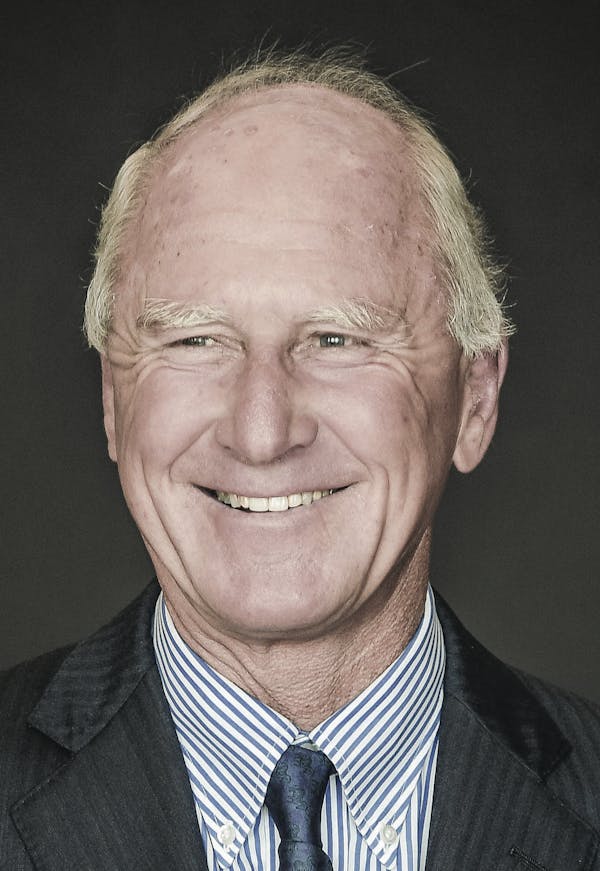
Byrnes, Marc
2016 - Oswald Cos.
Marc Byrnes has imbued the Oswald Cos. with a spirit of collaboration and a focus on the greater good.
Marc Byrnes leads the way into his office on the 15th floor of the Oswald Centre in downtown Cleveland and stops before an arrangement of black-and-white photographs. In one, U.S. Supreme Court Justice Oliver Wendell Holmes Jr. crosses Boston’s Congress Street in the city’s financial district. In others, British Prime Minister Winston Churchill flashes the “victory” sign in Harvard Yard, Lou Gehrig and Babe Ruth chat, legendary boxer Rocky Marciano dances in a locker room, General George Patton makes a speech in Washington D.C. and aviator Charles Lindbergh’s “Spirit of St. Louis” stands ready for takeoff.
The 62-year-old Oswald Cos. chairman explains that he admires Holmes’s perspective and empathy, Churchill’s candor, Gehrig’s humility, Ruth’s charisma, Marciano’s persevering fight, Patton’s bold and determined leadership and Lindbergh’s courage.
“[My wife Viki] had these framed for me,” he says “Each of them, if you think about their heroics or their strengths or their characteristics, has added a different dimension to my life.”
Byrnes has used those qualities to build Oswald Cos. into one of the 50 largest insurance brokers in the United States and one of the 25 biggest privately held entities of its kind in the country. Since he merged his Marc S. Byrnes & Associates insurance agency with the James B. Oswald Co. almost 30 years ago, the company has grown into an institution with almost 355 full-time employees set to exceed $75 million in annual revenues by servicing a mix of public-sector, private, corporate, nonprofit and individual clients, mostly based in Ohio and Michigan. Oswald board member Bill Mulligan, managing partner of Primus Capital with offices in Cleveland and Atlanta, credits his longtime friend with skillfully managing an employee-owned business that continues to grow and profit. Mulligan explains that Byrnes keeps the company in the hands of employees so they have the same opportunity he had to achieve professional success.
Byrnes started life as an orphan, given up as a newborn by his 19-year-old single mother. Attorney Larry Byrnes and his wife Judy adopted him as an infant and raised him as an only child. He graduated from University School, then studied history and economics at Williams College with the intent to teach history and coach football or swimming. But he decided to try selling life insurance in Boston after a road-trip pit stop to visit one of his greatest mentors, the senior vice president of Connecticut Mutual Life Insurance Co., Carter Schneider, a former Cleveland general agent who docked his 42-foot schooner at the Mentor Harbor Yacht Club at the same time the teenage Byrnes was coaching the club swim team and washing boats.
“They gave me a phone book and a rate book, and they said, ‘Go to work’ — that’s it!” he says of his instruction in selling what he still considers “the toughest product line in the world.”
Over the next five years, the self-driven Byrnes compiled an impressive book of business. In 1979, he embarked on a partnership with a Cleveland insurance agent he met at a Connecticut Mutual event for top-producers. The man was looking to work with someone younger who was familiar with the latest industry trends. “I understood the new wave of life-insurance sales relative to estate planning, buy-sell agreements, charitable planning — the use of insurance as a different tool, technically and financially,” Byrnes says. Two years later, after flying into Cleveland for five days every second or third week, he sold his Boston agency and devoted all his energies to building a counterpart in his hometown, where he branched into retirement planning and employee benefits. In 1983, he bought out his partner. But he wasn’t satisfied with just two employees in a downtown office.
“I liked building teams, integrating with others and working collaboratively with others,” he explains. “I wanted to build a really strong, what I would call a full-service, insurance organization.”
Byrnes quickly remedied the situation by becoming a solicitor with the James B. Oswald Co. In 1985, the independent brokerage employed 20 people — 16 or 17 in property casualty, the rest in workers’ compensation — and produced a couple of million dollars in annual revenues. At the time, Oswald was led by Jim Pender, John Warfel and Bob Bracci, three men who greatly influenced the rest of Byrnes’ career and how he ran his business. Pender actually created the original Employee Stock Ownership Plan (ESOP) for Oswald. “The company would not be where we are today without the guidance and work of these men. I wouldn’t be where I am today without these guys,” says Byrnes.
Four years later, in 1987, Byrnes merged his agency with Oswald, creating the company’s full-service employee benefits and financial services division. He started as vice-president and director of the life group and employee benefits division. A few years later, he faced his first crisis: The company lost its biggest client, a large manufacturer that represented close to 20 to 25 percent of its business. As recently promoted senior vice president, he motivated his employee-benefits team to make up the shortfall over the next year and convened an executive marketing committee charged with diversifying the company’s commercial client base.
“No one business in any given sector represents more than 2 percent of any of our revenues,” he says.
Byrnes advanced to president in 1996 and chief executive officer in late 1997 before being named chairman and chief executive officer in 2004. He considers hiring the right people his greatest accomplishment — and biggest challenge — of his career.
“When you build [a] culture of giving back — you’re all working toward the greater good, for the greater number — you actually create kind of a utilitarian mindset,” he explains.
Byrnes serves as board chair of the United Way of Greater Cleveland, a trustee of both the Rock and Roll Hall of Fame and Museum and University School, and a member of the Cuyahoga County Economic Commission Council.
“Most of it happens kind of underneath the radar,” observes Marianne Crosley, president and chief executive officer of the Cleveland Leadership Center. “He just puts the people who can make [things] happen together and then inspires, encourages, challenges them to make [them] happen.”
The work is motivated as much by gratitude as a sense of duty. He points out that Bellefaire JCB, which took him in, placed him in foster care and handled his adoption, is an agency funded by United Way and the Jewish Community Federation.
His charitable endeavors often produce clients, fellow board members who approach him about an insurance issue encountered in their personal or professional lives. “Rainmaking” is part of his job as Oswald chairman, along with servicing 20-plus major accounts, serving as an adviser to top executives and leading the board. He stepped down as chief executive officer in 2013. He kept the title of CEO through 2012 and then transferred CEO responsibilities to Robert J. Klonk on January 1, 2013. Klonk was a part of the executive team Byrnes created consisting of Klonk, David Jacobs, president and COO, and Joe DuBois, chief financial officer, who now lead the company. “It was a very important thing for me to create a succession team that will continue to sustain employee-ownership and perpetuate our independence as a privately held-company.
“I wanted to give the control to those that had helped me build this organization here and now.
“At least for another three years,” he declares, “I’m dedicated to serving as chairman of the Oswald Cos.
“I’m very grateful for my wife Viki and three wonderful sons Matt, Kyle and Gregory as well as my 92-year-old father Larry for all their love and support.”
Written by Lynne Thompson

)